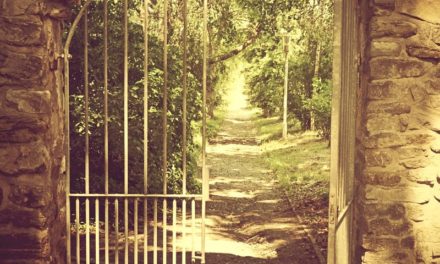When we look at the layout of the Sanctuary (as God designed it), we see very clearly the Gospel plan. But the first thing we notice is that both the Sanctuary and the Gospel are designed to reach us in our depravity, self-centeredness, and despair–far beyond the linen walls (where most sanctuary studies begin).
If we were to do a “Google Earth Search” for the Sanctuary back in Moses’ day, we wouldn’t find it on a lonely mountaintop, or on the edge of some large city, but rather ensconced in the very center of a large encampment of hundreds of thousands of nomadic tents. The purpose for this quickly becomes evident when we use a foot approach, which I did in my book What Converted Amun? [available upon request]–a story of conversion based on the sanctuary model.
From miles away the Cloud of God’s Presence could be seen and the fragrant incense detected. This illustrated the first act of the Gospel, to inspire hope — not to condemn, nor even to teach, but rather to draw. In the case of the first Sanctuary model, this drawing was through the encampment, where God’s people lived. In the book the self-absorbed Amun saw things that his wildest imaginations couldn’t have envisioned after 23 years of absence: millions of people thriving in a harsh wilderness, no sickness, no putrid smell of open latrines, and order–not a stiff, regimented order, but one respecting the needs of others. And, of course, the daily manna and clothes that didn’t seem to show signs of wear. All this would raise BIG questions to one living in Egypt where diseases and ailments were common and where gods would make the harshest demands on the worshippers but give little in return. By the time he reached the inner edge of the camp, where the Sanctuary was, the visitor would be “conditioned” for what he would see, his first view of the sanctuary, 1/2 mile away.
In front of him, in the distance, all that stood out was a long white wall surrounding a tall dark box-like structure on the west side and a thin column of smoke rising on the east side– nothing to appeal to a heart encumbered with worldliness. That white wall was to captivate the attention for it portrayed the pure righteous character of God’s followers. And far above was that mysterious cloud that never seemed to dissipate by the scorching dessert sun, but instead provided merciful shade to the people below. Yet before one could even get close to those bright linen walls, a large open wilderness would have to be traversed. There was no sneaking across it., and there was only one reason for heading towards the bullseye–to draw closer to God. It was in God’s design that by the time a stranger got his first view of the sanctuary his interest would be peaked. He would have seen enough of how the sanctuary (Gospel) system benefitted its followers that (if there were any hope of transformation) idle curiosity would now be replaced by a longing desire for something better. If that longing was strong enough to overcome pride then HOPE would be born. God knew that without hope humility and contrition –needed to come into God’s presence (Psalm 51:17, Isa 57:15)– would overwhelm the soul.
The courtyard shows how we are saved, and there FAITH is added to HOPE. Everything in the courtyard is mostly brass or covered with it (a metal made by man–usually copper + zinc— used to represent something transpiring on earth). So the courtyard expresses what the Messiah will do on this earth in our behalf…as a man. His incarnation, perfect life, undeserved death, and resurrection are all portrayed in the linen hangings, door, furniture, and activities in and around the courtyard. The only “works” of the sinner is the slaying of the Lamb (not a glorious “work” we can be proud of).
The blood captured from the lamb, however, goes beyond the courtyard, into what is represented as the “heavenlies” (the Holy and Most Holy Places), where only pure metals (gold and silver) are used and angels portrayed in the hangings, [in the ten curtains on the underside covering the Holy and Most Holy (Exo 26:1, 36:8) and in the vail between the Holy and Most Holy Places, (26:30-31, 36:35)], and priests’ work, representing what the Messiah will be doing in our behalf. This tells us Christ’s ministries for us continue beyond the death of the cross, and underscored in Hebrews 4:14, 8:1-2, 6 (spoken in present tense “He is the mediator of a better covenant”, not was). In the Sanctuary system atonement was not completed by the slaying of the lamb. Neither does the Gospel end at the cross. Its blood must be distributed by a priest throughout the Sanctuary. Sin is not easy to eradicate.
It is in the Holy Place that we see WORKS, but, interestingly again not performed by man but priest (representing what the Messiah does on our behalf). The candlestick can represent our light (the Light of God’s Son within us –John 1:4, 8:12, 9:5) or witness (Matt. 5:16). And what is the purpose of the light? (“that they may see your good works, and glorify your Father which is in heaven”). Nothing said about our salvation, but rather glorifying the Father. This is the theme of the Holy Place. It is also repeated in the Table of Shewbread, on which 12 unleavened cakes (loaves) of bread are neatly stacked. Why unleavened? Because they represent the body of Jesus without any defilement (Luke 22:19). Leaven = hypocrisy (Luke 12:1), and bread also is often associated with works (Ecc 9:7, 2Th 3:12). So whose works are portrayed here? Christ’s, our High Priest, (again on our behalf). The Altar of Incense also places the emphasis on the prayers of the Messiah for us (Luke 22:32), mixing His merits (the incense) with them. Everything in the Holy Place is what Jesus is doing for us on a daily basis… to sanctify us (John 17:19, 1Cor 1:30). It is also a model for our life, so we can glorify the Father—living out the life He has put within us by His indwelling Spirit (Psa 51:10, John 14:17, 1Cor 3:16). It is these kind of works that James says must accompany faith, or faith will do no good–works that glorify the Father (not us).
This is why those “full of good works” (Acts 9:6) are held up so high in the N.T.– because those works are not for our sake, but to glorify God (1Cor 6:20)! Our salvation is secure in Jesus. But the world sees Him in us (1Pet 3:1), so when we, by the grace of God, live out the Law written in our hearts, it shows our neighbor what God is like, and draws them to Him through our faithful witness.
Obedience to the Law is not to make us better, but our neighbor. It is to woo them towards a better life.
Paul said we are to die daily (as he did). This is a death to self. But yet we still live… in the life of Christ. It’s His faithful obedience to His Father’s commandments and will (John 15:10) that is our identity and righteousness, not the works we do. Then our “good works” (Matt. 5:16) glorify God who made it possible (Philippians 2:12).
This is the purpose of witnessing, to speak only of Christ and the Father, as even the Comforter does (John 16:13). Since the Law (the one written by God in stone with His own finger) is a reflection of His character then living in obedience to it would glorify Him, not us. It is not our law nor our show. There is no merit toward salvation in “keeping the law”, but there is a breaking of the Covenant with Him when we choose to be disobedient to His Word and Will (John 14:15, 21, 15:10). If we truly love Him (and want to glorify His name in our life) we will also want to do His will and be obedient to His commandments (Psalm 119:97, Isa 58:6-14, James 1:27).
This is expressed very simply in real life. Someone can give me a free ticket to some fancy resort in a faraway place. There would be NO EXPENSE on my part while I am there. I would have all the food I want, be able to take advantage of sightseeing trips freely, use guides and servants without charge. The whole trip would be a gift of grace (wholly unearned and undeserved). But I can refuse the gift (my own choice). It would be silly to have the gift offered to me but the ability to accept it is kept from me. What kind of benefactor would that portray? (Some people actually believe God does that.)
Yet there is one more part of the Gospel, illustrated by the Most Holy Place, and rarely spoken of. It’s called DEVOTION. This may not seem like anything difficult, but it is, for it requires a complete surrender of self to the love of your life. It follows a close walk with the Lord, an awareness of His deep love for us, and our utter helplessness without Him. This is what characterized Paul’s life, what pushed him in his ministry, why he willingly suffered “for Christ’s sake”, and gave everything he had into his ministry. This is what “the faith of Jesus” is (Rev. 14:12), what caused Him to stay on that cross, even with the possibility that He may never see His Father again. We must be willing to reach this part, for if we follow Jesus He will enter that Most Holy space before sin can be completely “blotted out” (an action that Acts 3:19 puts in the future, “when the times of refreshing shall come…”).
Hebrews 9:28 says that when Christ comes again (what we call the Second Coming) He shall appear “without sin”. Sin will be forever separated not only from us, but from Christ Himself and the heavenly Sanctuary.
So Christ was once offered to bear the sins of many; and unto them that look for him shall he appear the second time without sin unto salvation.
It will finally have been removed from Him. But the Sanctuary system speaks of only one way that the priest could cleanse himself of the sins of the people, and that was on the Day of Atonement, when all the sins of the congregation that the high priest has borne are transferred to the scapegoat which is led out into the wilderness by a “fit man”. This can be followed in Leviticus 16.
As this completes the Sanctuary process so it also completes the Gospel. The Gospel is not only the “Good News” for sinners (that by the grace of God and the sacrifice of His Son sinners can be reclaimed and join the heavenly family), it is also the “Good News” for all of heaven, that sin will never rise a second time, that God’s name will be exonerated before fallen angels and the whole universe.
The Gospel takes all this in. But there is one more part of the Gospel, one more condition, that is essential to know. Whatever our Saviour has done or is doing or will do is effective for us AS LONG AS we continue to follow Him and do His bidding. If He goes where we do not choose to go, then we have chosen to put our will above His, and His merits are no longer available.
The classic example is the Tree of Knowledge in the Garden of Eden. God made it very clear that the fruit of that tree was not necessary for them; that it was, in fact, off limits for eating. Were there not plenty of other trees and vines filled with choice fruit? When the two decided to put their will above God’s they had to leave that beautiful garden home God had so graciously provided.
This also applies to the levels in the Sanctuary. In the courtyard, Jesus takes our sins and guilt upon Himself, leaving us holding a free ticket to heaven and eternity. But then He moves into the heavenly Tabernacle to continue our growth in grace. Some of us may hold back.
“Why need I go there and learn all this sanctification stuff? My ticket is already paid for.” As this person looks back into the courtyard he sees another bright shiny being wearing a broad smile and saying, “No need to go there, Friend. Everything has already been done for you. Come on back and let’s have some fun!” If that person follows through with the second being’s invitation, he must turn his back on Jesus and lose the ground gained.
Then a time comes when our High Priest looks at His calendar and says, “I must be going now. I have some important things to do and papers to get in order before I close the door of the Sanctuary forever.” And with that He moves into the Most Holy Place with His Father. It is at this point that even a greater number of followers hesitate. And while they do a melodious voice from the Holy chamber is heard.
“God has done wonderful things for you through this sanctification process. You have learned a lot, and even the world about you has respected your new demeanor. Your thoughtfulness of others, your humility, your contributions to the community in sound judgment has earned you high commendations. And besides, remember you have not done any of this as a “works trip” but always as a testimony of what your God had done for you (Matthew 7:22). Why leave all this? What more is needed?”
Then in the distance you hear a heavenly choir singing, “All to Jesus I surrender, all to Him I freely give…” God is calling you to DEVOTION, to a full surrender… if need be of even life itself. This will be necessary for the final hours of life on this earth as we know it, for God will need a people who keep His commandments and have the faith His Son had on the cross–willing to fulfill His Father’s will no matter what. Later we may discuss just why that will be necessary, but not now.
Those who turn away from this call to full discipleship turn as the rich young ruler turned, and for similar reasons–for he was very rich (Luke 18:23, Rev. 3:16-17). Many will be satisfied with the riches of sanctification and refuse to give up all the ground they have gained. Abraham didn’t. If God said to sacrifice his only son Isaac, even though he be the son of promise, then that he must do. Job didn’t turn from God for any reason either. Both men were totally devoted to Him, and so will be His people at the end of Gospel times, when the times of refreshing come, so Christ can return without sin.
Now, let’s move onto other things: Into Not Through






